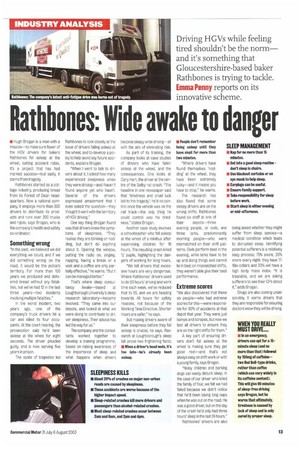Rathbones: Wide awake to danger
Page 13

If you've noticed an error in this article please click here to report it so we can fix it.
• Hugh Brogan is a man with a mission—to make sure fewer of the HGV drivers for bakers Rathbones fall asleep at the wheel, cutting accident rates. It's a project that has had marked success—but sadly, it stems from tragedy.
Rathbones started as a cottage industry, producing bread from its Forest of Dean headquarters. Now a national company, it employs more than 300 drivers to distribute its products and runs over 200 trucks and rigids, says Brogan, who is the company's heath and safety co-ordinator.
Something wrong
"In the past, we believed we did everything we could, and if we did something wrong on the road, it would be the police's territory. For more than 100 years we produced and delivered bread without any fatalities, but we've had 12 in the last three years—two incidents involving multiple fatalities."
In the worst incident, two years ago, one of the company's truck drivers hit a car and killed its four occupants. At the court hearing, the prosecution said he'd been asleep at the wheel for eight seconds. The driver pleaded guilty, and is now serving five years in prison.
The spate of tragedies led Rathbones to look closely at the issue of drivers falling asleep at the wheel, and to develop a policy to help avoid any future accidents, explains Brogan.
"When I went to talk to drivers about it, I asked how many experienced sleepiness when they were driving—and I haven't found anyone yet who hasn't. Several of the drivers expressed amazement that I even asked the question—they thought it went with the territory of HGV driving."
One key thing Brogan found was that drivers knew the symptoms of sleepiness. "They realise they are blinking or nodding, but don't do anything about it, Opening the window, putting the radio on, singing, napping, having a break or a walk and a coffee are only partially effective," he warns. But it can be managed better."
That's where sleep consul tancy Awake based at Loughborough University's sleep research laboratory—became involved. "They came into our depots, and looked at what we were doing to contribute to driver sleepiness. Their advice has led the way for us."
The company and the consultants worked together to develop a training programme, based on raising awareness of the importance of sleep and what happens when drivers become sleepy while driving—all with the aim of eliminating risk.
As part of its training, the company looks at case studies of drivers who have fallen asleep at the wheel, and the consequences. One looks at Gary Hart, the driver at the centre of the Selby rail crash. "The headline in one newspaper said that 'tiredness and cruel luck led to the tragedy'; he'd no control once the vehicle was on the rail track—the only thing be could control was his tiredness." states Brogan.
Another case study involves a schoolteacher who fell asleep at the wheel of a minibus after supervising children for 16 hours. The resulting crash killed 12 pupils, highlighting the dangers of working for long hours.
"We tell drivers that excessive hours are very dangerous. Where Rathbones' drivers used to do 60 hours' driving and work time each week, we've reduced that to 55, and we are heading towards 48 hours for safety reasons, not because of the Working Time Directive. Shorter hours are safer," he says.
But making drivers aware of their sleepiness before they fail asleep is crucial, he says. Research at Loughborough's sleep lab prove two frightening facts; • When a driver's head nods, It's too late—he's already been asleep. "Where drivers have found themselves 'nodding' at the wheel, they have been extremely lucky—and it means you have to stop," he warns.
The research has also found that some sleepy drivers are on the wrong shifts. Rathbones found six staff at one of their depots—three evening people, or owls, and three larks, predominantly morning people—who were mismatched on their shift patterns. Owls perform best in the evening, while larks have to be up and doing things and cannot lie in bed; on mismatched shifts, they weren't able give their best performance.
Extreme scores
"We also discovered that these six people—who had extreme scores forthis—were responsible for 60% of accidents at that depot that year. They were just bumps and scrapes, but now we test all drivers to ensure they are on the right shifts for them."
A key part of ensuring drivers don't fall asleep at the wheel is making sure they get good rest—and that's not always easy on shift work or with a young family, says Brogan.
"Noisy children and barking dogs can easily disturb sleep. In the case of our driver who killed the family of four, we felt we had failed because we didn't notice that he'd been taking long naps when he was out on the road. He was a good driver, but on the day of the crash he'd only had three hours' sleep in the last 24 hours."
Rathbones' drivers are also
being asked whether they might suffer from sleep apnoea—a medical condition which leads to disrupted sleep. Identifying potential sufferers is a relatively easy process; 75% snore, 20% snore every night; they have 1719in collars and 30% will have a high body mass index. "It is treatable, and we are asking sufferers to see their GPs about it," adds Brogan.
Drugs are also coming under scrutiny. It warns drivers that they are responsible for ensuring doctors know they will be driving.
































































































































































